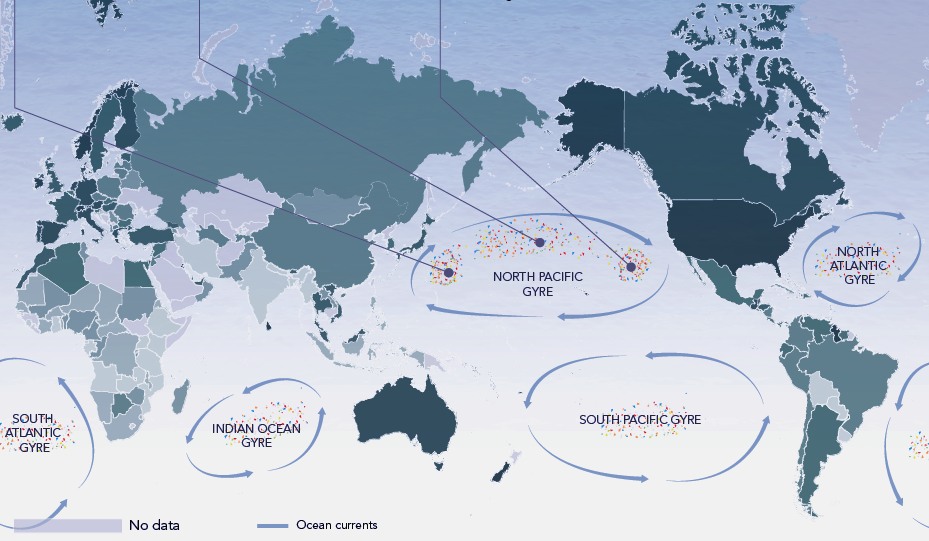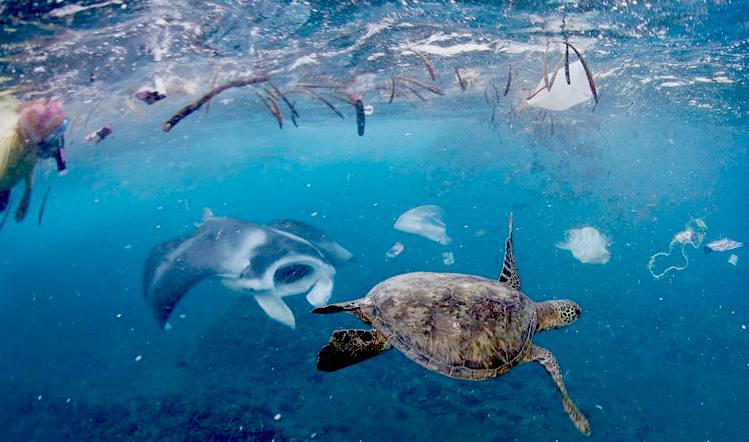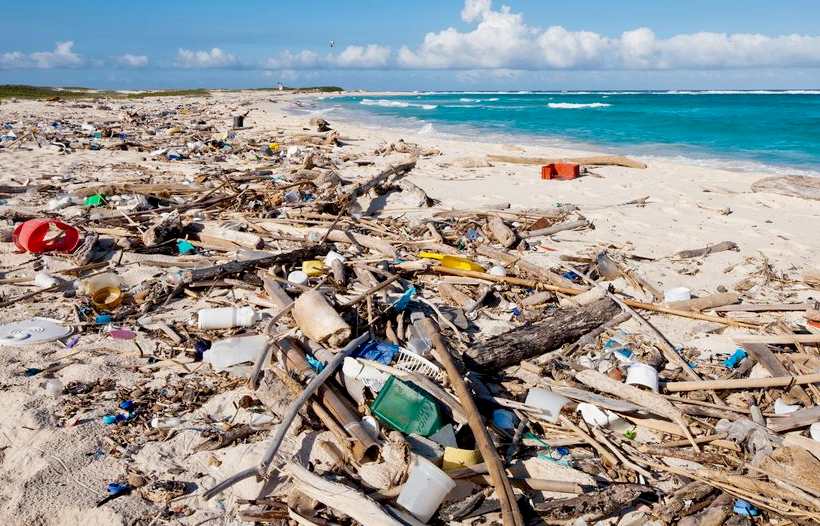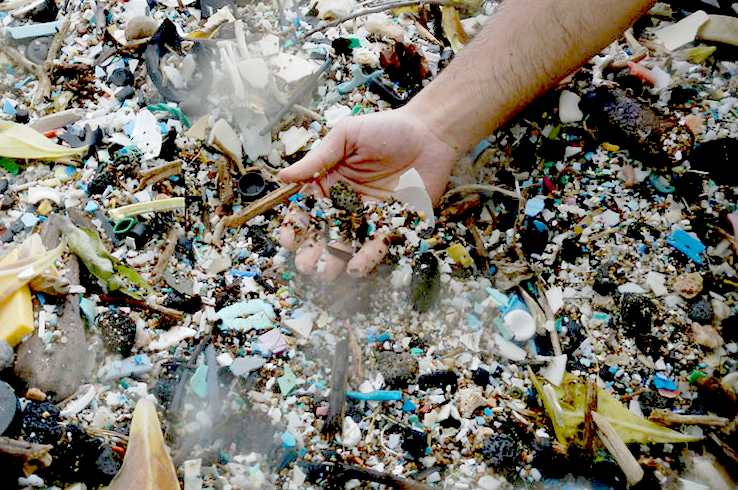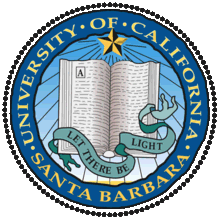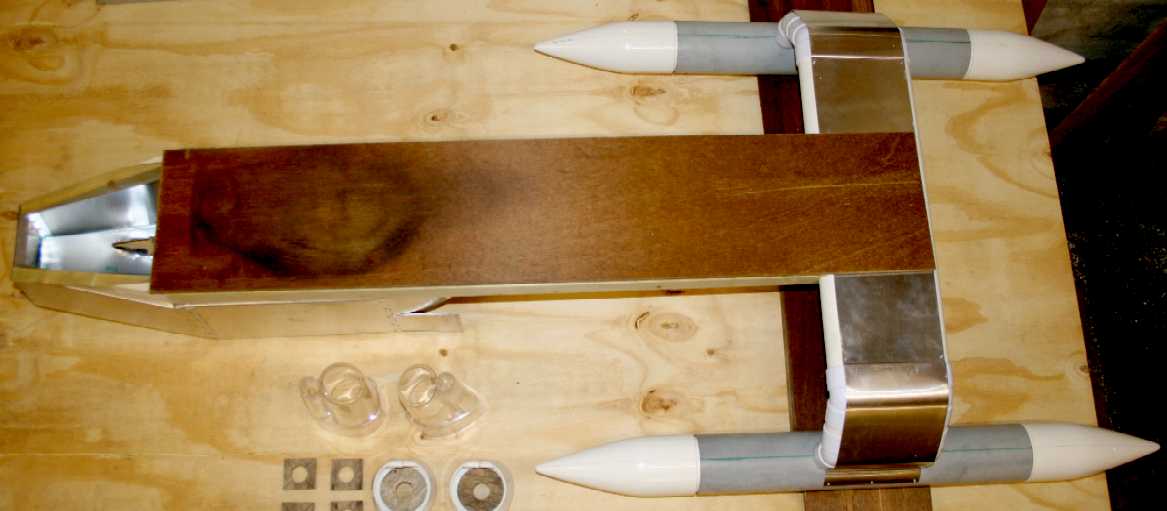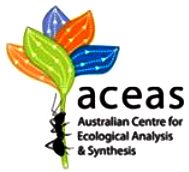|
NATIONAL CENTER for ECOLOGICAL ANALYSIS and SYNTHESIS
|
|
|
This world map derived from a National Geographic source, shows that the North Pacific Gyre is by far the largest - and divided into three regions, the western, sub-tropical-convergence zone and eastern garbage patches. We estimated these patches collectively to be around 80,000 tons in mass based on UN estimates, but have revised that up to 2.66 million tons based on the latest NCEAS estimates.
PLASTIC OCEAN WASTE
According to a new study by the NCEAS, 4 million to 12 million metric tons of plastic waste is thrown into oceans around the world every year.
The National Center for Ecological Analysis and Synthesis at the University of California, Santa Barbara conducted the study, focusing on marine debris.
Researchers behind the project predict that the volume of plastics found in oceans will double by 2025.
This work was supported by the National Center for Ecological Analysis and Synthesis, Ocean Conservancy, University of California, Santa Barbara, and the State of California.
A Manta Ray and Sea Turtle swim in a soup of plastic. The challenge is huge, the garbage is spread over millions of square miles. It is made up mostly of degraded plastic, broken down by sunlight and waves into tiny bits the size of grains of rice. Roughly 2.5 percent of the world's plastic ends up in the sea.
NCEAS REPORT - PLASTIC WASTE INPUTS FROM LAND INTO THE OCEAN
Plastic debris in the marine environment is widely documented, but the quantity of plastic entering the ocean from waste generated on land is unknown. By linking worldwide data on solid waste, population density, and economic status, we estimated the mass of land-based plastic waste entering the ocean. We calculate that 275 million metric tons (MT) of plastic waste was generated in 192 coastal countries in 2010, with 4.8 to 12.7 million MT entering the ocean.
Population size and the quality of waste management systems largely determine which countries contribute the greatest mass of un-captured waste available to become plastic marine debris. Without waste management infrastructure improvements, the cumulative quantity of plastic waste available to enter the ocean from land is predicted to increase by an order of magnitude by 2025.
With increased population and increased per capita consumption, waste will continue to grow if unchecked. Improving waste management infrastructure in developing countries is essential. Subsequently, while these improvements are being developed, it is imperative industrialized countries take immediate action by reducing waste and restricting single-use plastics - and by implementing programs for waste recovery, as soon as a workable solution presents itself.
PLASTIC WASTE INPUTS FROM LAND INTO OCEAN
Jenna R. Jambeck, Roland Geyer, Chris Wilcox, Theodore R. Siegler, Miriam Perryman, Anthony Andrady, Ramani Narayan, Kara Lavender Law
NCEAS Press Releases:
University
of California, Santa Barbara More information about this project's research, participants, and publications.
NCEAS
CONTACTS
NCEAS is located in the Balboa Building of Paseo Nuevo in the center of downtown Santa Barbara. The Center offers computing infrastructure, meeting rooms for small groups and two larger rooms which accommodate 18 and 25 people, as well as access to several larger conference facilities. A large lounge and kitchen are available for breaks, informal seminars and gatherings. The Center also includes a variety of offices that house resident and visiting researchers and in-house staff.
ABOUT NCEAS
The National Center for Ecological Analysis and Synthesis (NCEAS) is a research center at the University of California, Santa Barbara, in
Santa Barbara, California. Better known by its acronym, NCEAS (pronounced n-seas) opened in May 1995. Funding for NCEAS is diverse and includes supporters such as the U.S. National Science Foundation, the State of California, and the University of California, Santa Barbara.
NCEAS DIRECTORS
As holiday beaches go, this is an environmental and financial disaster.
It all goes back to our dependence on oil. The by product, plastic, is so useful that we could not do without it today. For that reason, we need to take responsibility for our needs, by making provision to clean up our mess sustainably. We cannot afford fleets of trawlers manned by humans to scoop up the harmful soup, and that is where semi-autonomous robots could come to the rescue.
Each year, oil companies remove approximately 3.7 trillion gallons of oil from the earth. This oil is transported by barges, ocean going tankers, and pipelines to refineries and storage facilities. It is inevitable that accidental leaks and spills will take place on a regular basis, where oil is mostly transported across vast oceans. That is the first stage of oil pollution. The second stage is oil byproduct pollution from plastic.
NCEAS HISTORY & FUNDING
The pier at Santa Babara
SANTA BARBARA
Santa Barbara is the county seat of
Santa Barbara County, California. Situated on a south-facing section of coastline, the longest such section on the West Coast of the United States, the city lies between the steeply rising Santa Ynez Mountains and the Pacific Ocean. Santa Barbara's climate is often described as Mediterranean, and the city has been promoted as the "American Riviera". As of the census of 2010, the city had a population of 88,410, a loss of 1,190 from the previous census, making it the second most populous city in the county after Santa
Maria while the contiguous urban area, which includes the cities of Goleta and Carpinteria, along with the unincorporated regions of Isla Vista, Montecito, Mission Canyon, Hope Ranch, Summerland, and others, has an approximate population of 220,000. The population of the entire county in 2010 was 423,895.
CALIFORNIA UNIVERSITY
The
University of
California, Santa Barbara (commonly referred to as UC Santa Barbara or UCSB) is a public research university and one of the 10 general campuses of the
University of California system. The main campus is located on a 1,022-acre (414 ha) site near Goleta, California, United States, 8 miles (13 km) from Santa Barbara and 100 miles (160 km) northwest of Los Angeles. Tracing its roots back to 1891 as an independent teachers' college, UCSB joined the University of California system in 1944 and is the third-oldest general-education campus in the system.
University of California, Santa Barbara
A report by the United Nations gives different figures for ocean waste, significantly undercutting the statistics of the NCEAS researchers. Once thing is for sure, there is a lot of plastic being dumped in our oceans at the expense of wildlife and the food chain that supports humans.
We cannot stand by and do nothing while we poison the oceans and kill thousands of animals every year with our cavalier attitude to waste disposal.
SEAVAX FEASIBILITY - This is a raw proposal for a robot ship that is designed to vacuum up plastic waste from the ocean based on the patent Bluefish ZCC concept. The vessel is solar and wind powered - and shares components with other ZCC variants. The front end (right) is modified so that there is a wide scoop area, into which plastic waste is funneled as the ship moves forward. The waste is pumped into a large holding bay after treatment, then stored until it can be off-loaded at the rear of the ship. The onboard command systems can be semi-autonomous, such that in robot mode they alert HQ to any potential problems and share data as to progress for operators. A whole cleanup mission can be controlled from land, with visuals and data streams. A SeaVax would operate using a search program called SeaNet.
LINKS
National Geographic 2014 ocean garbage patch plastic pacific debris The Telegraph Great Pacific Garbage Patch has increased 100 fold since the 1970s Plosone ocean pollution article Fjournal pone 0111913 The Guardian 2014 December full scale plastic worlds oceans revealed first time pollution Robotics Tomorrow ocean pollution Daily Dot technology ocean cleaning drone Interiorholic gadgets ocean robot cleaner PSFK 2012 marine robots clean oceans hhttp://www.universityofcalifornia.edu/ http://en.wikipedia.org/wiki/University_of_California,_Santa_Barbara http://www.nsf.gov/ http://www.nescent.org/ http://www.nimbios.org/ http://www.santabarbaraca.gov/ http://en.wikipedia.org/wiki/Santa_Barbara,_California http://www.santabarbaraca.com/ http://www.ciee-icee.com/ http://www.aceas.org.au/ http://www.unep.org/ http://www.unep.org/environmentunderreview/ http://news.nationalgeographic.com/news/2014/04/140414-ocean-garbage-patch-plastic-pacific-debris/ http://www.plosone.org/article/info%3Adoi%2F10.1371%2Fjournal.pone.0111913 http://www.roboticstomorrow.com/content.php?post_type=1919 http://www.dailydot.com/technology/ocean-cleaning-drone/ http://www.interiorholic.com/other/gadgets/ocean-robot-cleaner/ http://www.psfk.com/2012/07/marine-robots-clean-oceans.html http://www.unep.org/environmentunderreview/
Youtube ocean pollution
ACIDITY - ARCTIC - ATLANTIC - BALTIC - BERING - CARIBBEAN - CORAL - EAST CHINA - ENGLISH CH
GULF MEXICO - INDIAN - MEDITERRANEAN - NORTH SEA - PACIFIC - PERSIAN GULF - SEA JAPAN - STH CHINA
|
|
|
This website is Copyright © 2015 Bluebird Marine Systems Ltd. The names Bluebird, Bluefish, SeaVax, SeaNet and the blue bird and fish in flight logos are trademarks. CONTACTS The color blue is a protected feature of the trademarks.
|
